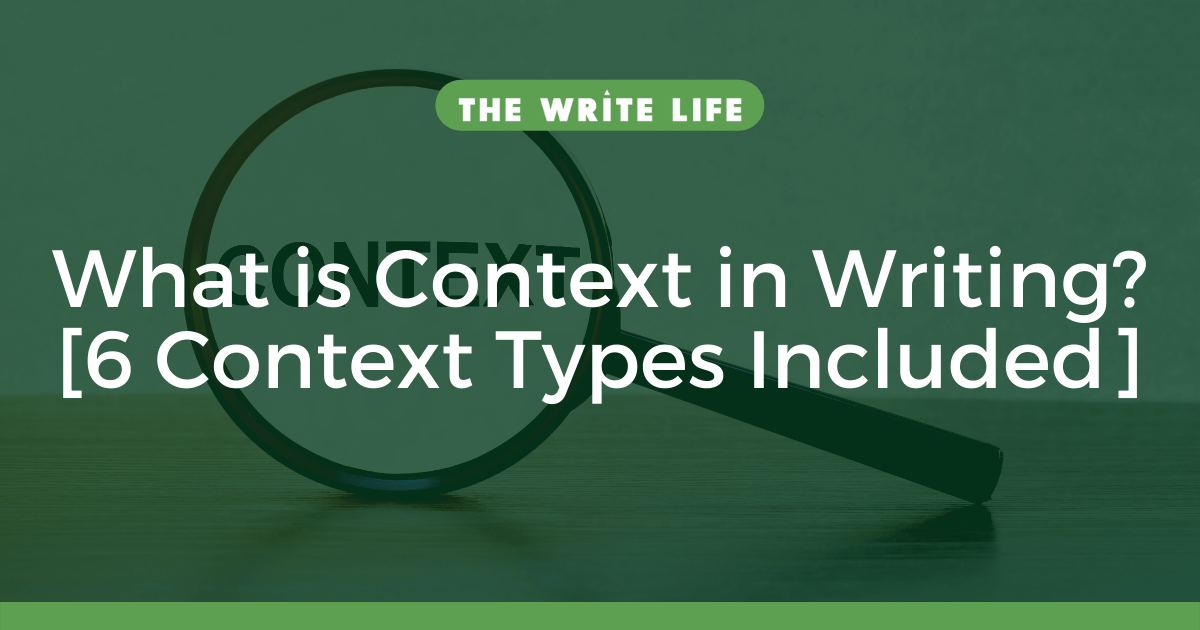
While it’s essential to have a good story, giving context in your writing is key to giving the story meaning.
Imagine you’re in a bookstore and you pick up a book with an intriguing title. You open it to start to read the first chapter and it’s dialogue between a few characters.
Imagine reading it for a few pages but there’s no hint to who the characters are or what is going on. There are a lot of emotions but there’s no context or understanding of what is happening in the story. You would get frustrated and most likely put the book back down.
This is exactly why context in writing is so important. It gives your readers a full understanding of the setting, what is happening between characters, and gives meaning behind all of the events happening.
Imagine reading something like Harry Potter but with no context that they’re in a world where magic exists. Or reading a Jane Austen novel without knowing the family dynamic or the social dynamics.
When you provide the reader with context, they can comfortably follow the story because they know what’s happening and why certain characters do what they do.
We’ll go over what context is, the types you can give readers, and how to integrate it in your overall writing.
What is context in writing and why does it matter?
Context helps to give your writing meaning.
Have you ever had something in your life taken out of context? You sat back and thought, “That’s not what I meant!”
The exact same thing can happen to your writing, which is why you need to include it in your writing.
Most of the books you’ve read give you context behind what you’re reading. Let’s go through some examples. (Potential book spoilers ahead!)
If you had to read The Great Gatsby in high school, you most likely remember the New York setting in the famous Jazz Age. Knowing the context of Gatsby being in love with Daisy gives the entire story meaning and helps you understand why Gatsby does what he does.
In the classic story Dracula, it’s essential to know it takes place in the late 1800s and takes place in both Transylvania and England. This sets the overall mood of the location and the customs at the time.
Then, take something such as Lord of the Rings. To read the book, you’d need to understand all of the wars that have gone on, what this fictional world is like, and who all of the major characters are to even begin to read it all.
Of course, there are deeper levels of context as well.
In the famous story of Uncle Tom’s Cabin, it’s important to know it was written before the Civil War and had a tremendous impact on the abolitionist cause in the 1850s.
There are many layers to a story, the era of when it was written, and also the author’s life story that influences the overall angle of the book. Of course, this won’t matter as much as when you’re writing the story, but you need to remember these elements if you’re pulling inspiration from other writers.
Types of context in writing
There are various forms of context you might need to include to give your readers an accurate understanding of the story. This might not include every single type of context you would need for your story, but it will give you a great place to start. You can find other storytelling tips here.
All of these help either explain the situation your characters are in or it gives the reader a deeper understanding of why they act the way they do.
Location context
This can range anywhere from the physical location in the world to a whole new world that you’re creating and giving them context. If you’re writing about characters in space that will form a different context than characters on the open ocean.
Keep in mind, if you’re creating a whole new world that does not exist in our real one, you will need to give a lot of context to build the world in the readers’ mind. Some examples of this include Lord of the Rings or Star Wars.
Historical context
Giving the historical context of a place can help readers understand what’s going on. For example, you might need to include wars, the history of the landscape or town, what the area is known for, or anything else you might need to include.
Knowing the timeframe of a story can also help readers understand things such as what type of technology might have been created already or if there are certain economic conditions happening.
Situational context
You might need to include other storylines to give the reader context into what is happening. Some examples might include a recent divorce between characters, an upcoming court case that’s pending, if a character just got out of prison, and so on.
This one is particularly key to understanding why characters are feeling or acting a certain kind of way.
Emotional context
Providing your readers with emotional context can help explain why some dialogue happens in a particular way. For example, if a simple conversation about coffee creamer turns explosive, it is a good idea to inform the reader that this is happening because both of these characters have tension due to fighting over a family’s inheritance.
Cultural context
The type of culture your story takes place in will change a lot of the context. Keep in mind the type of audience you’re writing to as well because that will change how much or how little explanation you’ll need to include.
Readers who did not grow up in a certain culture might need more thorough explanation than people who are native to an area. You might consider including certain types of foods or rituals from different parts of the world.
Cultural context can also include the social and political undertones that are taking place throughout your story, too.
Linguistic context
How people talked in the past and in different parts of the world can have a huge impact on your overall dialogue. For example, how characters speak in Shakespeare’s stories and how Millennials talk is worlds apart.
If you’re going to include slang and other shorthand words, you may or may not need to include an understanding of what those words mean or you might decide that it’s not important to include.
How to give context in writing
Now that you know what context in writing is, we’ll go over how to include it in your writing.
If you are writing a book, the single biggest factor you need to include is all of the context someone would need to get interested in your story.
If you give too much context, you might give your reader too much information at once and lose them while you explain everything they need to know. However, if you give too little context, they won’t understand what’s happening.
You’ll need to find a delicate balance between your context and your story. You don’t want them to feel like they’re reading a history book instead of a story.
To start, you’ll want to go through the categories from the last section and figure out what parts you’ll need to include in your story.
Depending on the story and your overall writing style, you might also need to think about what you want to keep a mystery or not. Not everything has to be explained, especially if it’s going to end up spoiling the story.
Know your intended audience
You’ll need to know your intended market / audience before you start to write anything. That will give you an idea of what to include or not include. For example, if you’re writing a book for business executives, you don’t need to include explanations for basic business things they already know.
Keep in mind, you might have readers who are not your intended audience find and read your writing. You will need to decide what to include or not include in case this happens.
Use characters to give context
One fun way to include context in your story is to have your characters tell stories and include the context. That can prevent you having to give a long exposition to get them up to speed. Inside of dialogue and discussions you can include the history between characters or give readers an understanding of what is happening and how they’re feeling about it.
Get feedback when you can
You’ll want to get feedback when you can. That will help you figure out what is missing in the context of your story. It’s hard to judge what is missing from your story when you are the one writing it and you know it all so well.
Conclusion
Context in storytelling is essential to making sure you’re telling a good story. You’ll want to find a good balance between giving them enough information but not too much information. To learn more about the craft of writing Fiction, check out this free training we have in conjunction with Self-Publishing School.


